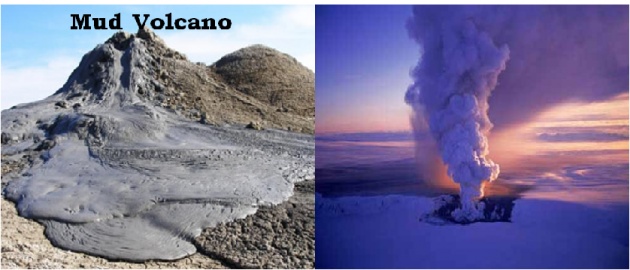Mud Volcanoes or Mud Domes: These are the mud-like or mudddy formations created by the emission of liquids and gases from the earth. The largest structures are 10 kilometers in diameter and 700 meters in height.

Composition and Texture of Lava:
Composition: If the erupted lava contains a high percentage of silica (>63%), the lava is called FelsicIf the erupted lava contains 52%–63% silica, the lava is said to be of Intermediate Composition,If the erupted magma contains from 52% to >45% silica, the lava is called Mafic (because it contains higher percentages of Mg and Fe). These lavas are usually much less viscous than the Rhyolitic (fine-grained in texture but containing granitic composition) lavas; they are also hotter than the Felsic lavas.
Texture: Two types of lava are named according to the surface texture: Aa and Pa’hoehoe (both are Hawaiian words). Aa is characterised by a rough, clinkery (a lumpy mass ejected by the volcanoes) surface and is a typical texture of viscous lava flows (lateral, surfacial streams of molten lava issuing from a volcanic cone or fissure).
Pa’hoehoe is characterized by its smooth and wrinkly surface and is generally formed from more fluid lava flows Only Mafic flows erupt as Pāhoehoe because they erupt at higher temperatures and have the proper chemical composition to allow them to flow more fluently.
Ordinary Classification of Volcanoes:
Active: They can be active, erupting after a few days or million of yearsExtinct: They don’t have any magma supply to give any volcanic eruptionDormant: Yellowstone Volcano (in Wyoming, USA) erupted 70 thousand years ago after the period of 2.1 million years.
Technical classification of volcanoes:
Volcanic-Alert level: Extinct volcanoes have again erupted; so new classification system has been adapted to describe the levels and stages of volcanic activityVolcano Warning Schemes different colours designate the different volcanic stage.
Types of Volcanic Activities:
Types of Volcanic Eruption:
Lava, Tephra and Gases are expelled Phreatic Eruption: Steam-generated eruptions Explosive Eruption of Rhyolite Effusive Eruption of Low-silica Lava e.g. Basalt Pyroclastic Flows: Fast moving ejection of Tephra (solid matter ejected into the air together with high pressure gases by an erupting volcano)Emission of Carbon Dioxide Earthquakes, Hot-springs, Fumaroles, Mud-pools and Geysers often accompany volcanic activityWater-vapurs are typically the most abundant volcanic gas, followed by Carbon Dioxide and Surfur Dioxide. Other principal volcanic gasesinclude Hydrogen Sulfide, Hydrogen Chloride, and Hydrogen Fluoride, together with organic compounds and volatile metallic chlorides The most significant impacts from these injections come from the conversion of sulfur dioxide to sulfuric acid (H2SO4), which rapidly condenses in the stratosphere and forms fine sulfate aerosols (Aerosol: a gaseous suspension of fine solid or liquid particles usually under pressure). The aerosols increase the Earth's Albedo (reflecting power of a surface) i.e. reflection of Sun’s radiation back into space and thus cool the Earth's lower atmosphere i.e. troposphere. They also absorb the heat excited from the Earth crust, thereby warming the atmosphere Many eruptions during the past yeahrs have caused a reduce in the average temperature of the Earth's surface up to half a degree C for the period of one to three years



